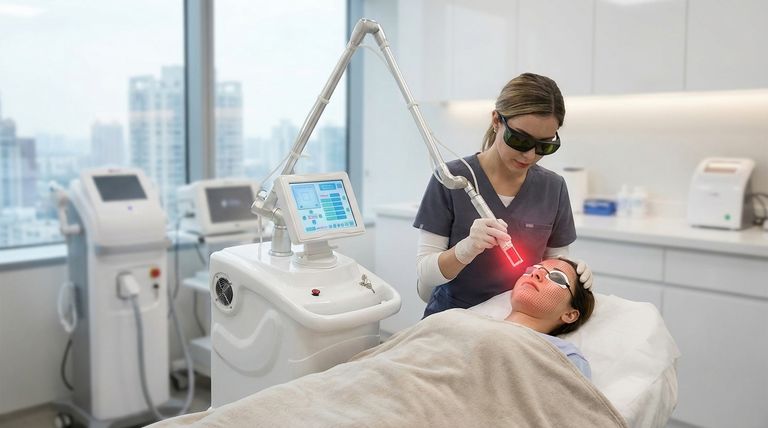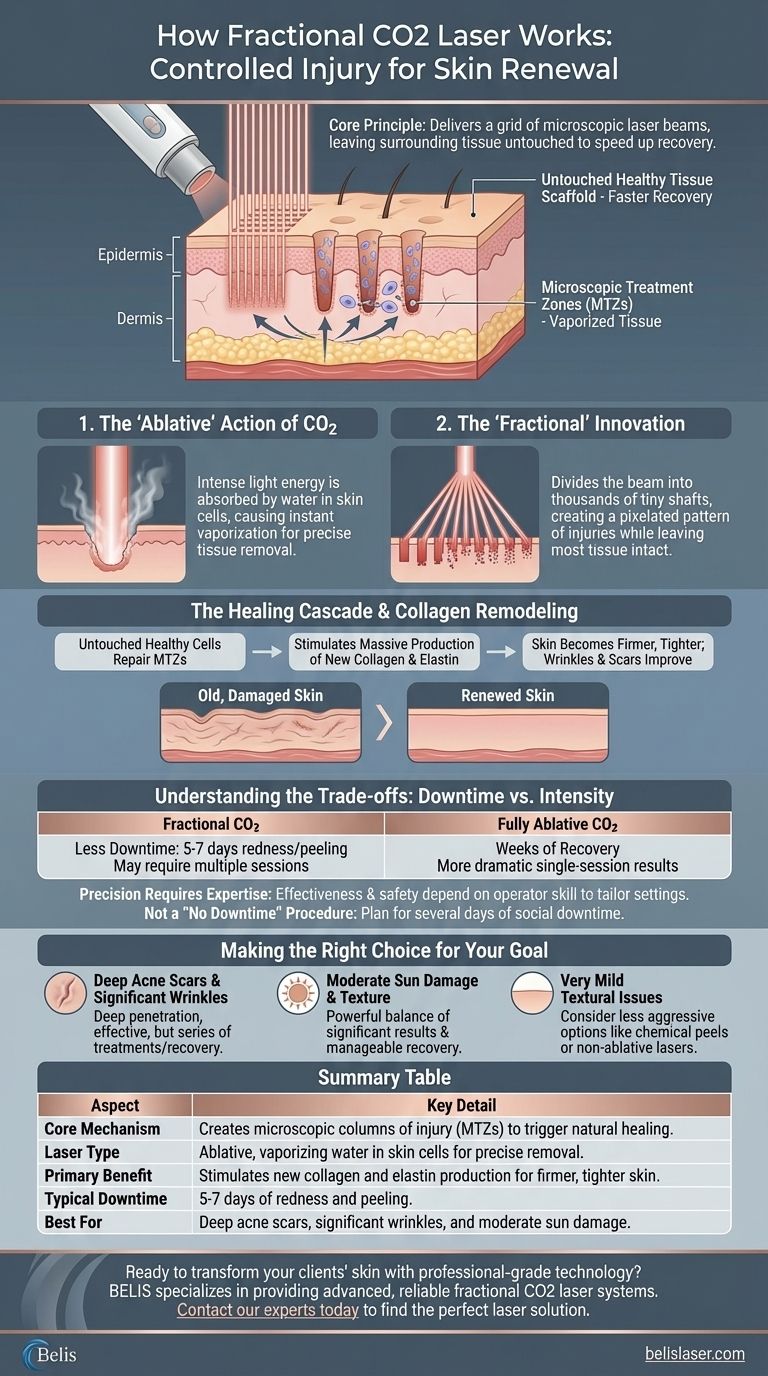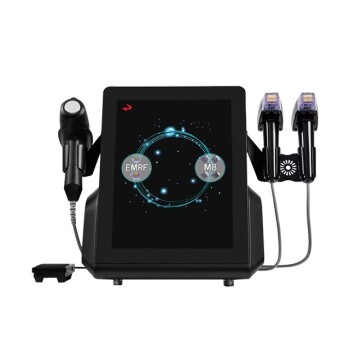In short, a fractional CO2 laser works by delivering a grid of microscopic laser beams to create tiny, deep columns of injury in your skin. These controlled injuries trigger a powerful, natural healing response. Critically, the laser leaves the surrounding skin tissue completely untouched, which dramatically speeds up recovery time.
The core principle of fractional CO2 laser treatment is not just about removing damaged skin, but about leveraging the body's own healing mechanisms. By creating precise micro-injuries while leaving a "scaffold" of healthy tissue, it stimulates comprehensive renewal from the inside out with significantly less downtime than traditional methods.

The Core Mechanism: From Controlled Injury to Renewal
To understand how fractional CO2 lasers rejuvenate the skin, we must look at both the laser's action and the skin's reaction. It's a precisely controlled two-step process.
The "Ablative" Action of CO2
A CO2 laser is an ablative laser. This means its light energy is intensely absorbed by the water inside skin cells, causing them to be instantly vaporized.
This action effectively removes, or "ablates," a microscopic column of tissue. It is this precise removal of old, damaged skin that addresses issues on the surface.
The "Fractional" Innovation
Instead of treating the entire skin surface at once, a fractional laser divides the single beam into thousands of tiny shafts of light. These shafts strike the skin in a pixelated or grid-like pattern.
This approach creates thousands of microscopic treatment zones (MTZs) deep within the skin, while leaving the majority of the surrounding tissue intact and unharmed. Think of it like aerating a lawn—you treat small sections to improve the health of the whole area.
The Healing Cascade and Collagen Remodeling
The real magic happens after the laser has done its work. The small islands of untouched skin immediately begin the healing process.
These healthy cells rush to repair the microscopic columns of ablated tissue. This powerful healing response stimulates a massive production of new collagen and elastin—the essential proteins that give skin its firmness, structure, and elasticity. This new collagen fills in wrinkles, plumps scars, and tightens the skin over the weeks and months following treatment.
Understanding the Trade-offs
While highly effective, the fractional approach involves a clear set of trade-offs compared to other resurfacing methods.
Downtime vs. Intensity
A fractional CO2 treatment has significantly less downtime (typically 5-7 days of redness and peeling) than a traditional, fully ablative CO2 laser, which could require weeks of recovery.
However, because it treats only a fraction of the skin, the results from a single session may be less dramatic than a fully ablative treatment. Multiple sessions are often needed to achieve the same endpoint.
Precision Requires Expertise
The effectiveness and safety of the procedure are highly dependent on the skill of the operator. The device's settings—such as the depth and density of the laser columns—must be tailored perfectly to your skin type and goals.
An inexperienced operator can increase the risk of side effects like scarring or pigmentation changes.
It Is Not a "No Downtime" Procedure
While recovery is faster than older methods, it is incorrect to view this as a "lunchtime" procedure. You must plan for several days of social downtime as your skin goes through a period of redness, swelling, and peeling.
Making the Right Choice for Your Goal
Selecting a resurfacing treatment depends entirely on your specific goals for improvement and your tolerance for downtime.
- If your primary focus is treating deep acne scars or significant wrinkles: The deep penetration of the fractional CO2 laser makes it one of the most effective tools available, but be prepared for a series of treatments and the associated recovery.
- If your primary focus is moderate sun damage and improving overall texture: A fractional CO2 treatment offers a powerful balance of significant results with a manageable recovery period.
- If your primary focus is very mild textural issues with zero downtime: You might consider less aggressive options like a series of chemical peels or non-ablative fractional lasers.
Ultimately, the fractional CO2 laser is a powerful technology for stimulating profound skin renewal by expertly balancing injury and healing.
Summary Table:
| Aspect | Key Detail |
|---|---|
| Core Mechanism | Creates microscopic columns of injury (MTZs) to trigger natural healing. |
| Laser Type | Ablative, vaporizing water in skin cells for precise removal. |
| Primary Benefit | Stimulates new collagen and elastin production for firmer, tighter skin. |
| Typical Downtime | 5-7 days of redness and peeling. |
| Best For | Deep acne scars, significant wrinkles, and moderate sun damage. |
Ready to transform your clients' skin with professional-grade technology?
BELIS specializes in providing medical aesthetic clinics and premium beauty salons with advanced, reliable fractional CO2 laser systems. Our equipment is designed to deliver safe, effective, and consistent results, helping you build trust and grow your business.
Contact our experts today to find the perfect laser solution for your practice and unlock new levels of client satisfaction.
Visual Guide

Related Products
- Fractional CO2 Laser Machine for Skin Treatment
- Hydrofacial Machine with Facial Skin Analyzer and Skin Tester
- Pico Picosecond Laser Machine for Tattoo Removal Picosure Pico Laser
- Hydrafacial Machine Facial Clean Face and Skin Care Machine
- Ultrasonic Cavitation Radiofrecuency Machine for Body Slimming
People Also Ask
- How often should you do fractional CO2 laser? The 4-6 Week Rule for Optimal Results
- Is CO2 laser for all skin types? A Critical Guide to Skin Type Safety and Risks
- What does a CO2 laser do to your face? Achieve Profound Skin Resurfacing & Renewal
- What is the downside of a CO2 laser? Weighing Dramatic Results Against Downtime & Risks
- What is a fractional CO2 laser machine used for? A Guide to Advanced Skin Resurfacing



















